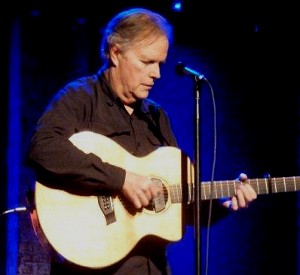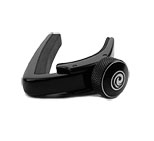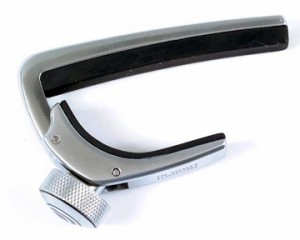With its sleek design, the Planet Waves NS Capo Pro weighs almost nothing and does its job very well for a reasonable price.
This may be the easiest review I have ever had to write. I love it. There isn’t a whole lot more that needs to be said.
But you know me…
Pros: Sleek, light-weight and simple to use for obtain good tone and intonation. No performance issues I can find in regular use.
Cons: Tightener knob can come off in a pocket or gig bag. Not as easy to use as a drop tuning capo as the Shubb. Not for those who like to keep their capo around the headstock.
Bottom Line: It does its job well and is built to last. My choice for a capo since it appeared on the scene and still the reigning champ.
The Planet Waves NS Capo was designed in collaboration with Ned Steinberger, inventor of the “stick” bass and other advancements in music-related engineering. The capo features ultra-light construction and a simple design that lets you slip it on, tighten it and get to playing. It is a radiused capo that will work with any acoustic or electric guitar with a radiused fretboard. But an unreadiused version is available for use with classical guitars, banjos and other instruments with flat fingerboards.
Compared to all other popular capos, it seems to weighs next to nothing, thanks to an aluminum alloy that was originally developed for the aerospace industry. It is also made with a slim profile that has few moving parts and very little protruding from the sleek main structure. It can be carried in any pocket and into any situation without adding bulk or unwanted weight. I hardly know it’s there at all, until its time to use it.
The capo is open at one end, with a long, rigid fretting bar that comes down around the side of the guitar’s neck and connects to a shorter back bar via a springy hinge. The shorter bar has a curve that then levels out toward the end. Once the fretting bar is in place, the player turns a knob that tightens the small bar, which hugs the neck firmly from behind.
The fretting bar is 1/4″ wide at the open edge and increases another 1/32″ at the other end, with the rubber pad being a bit thinner. This makes it among the narrowest capos available. It can be put on any guitar with the open end at either the bass or the treble side, including 12-strings. The wide screw knob isn’t too thick, nor is it overly shallow. It also has a nicely textured gripping surface around its edge. The micrometer screw turns without any noticeable resistance and there is no effort required to loosen it.
The rigid fretting bar is lined with a tough rubber padding that contacts the strings. The padding is not replaceable, as with capos that have rubber sleeves, but it is 3/16” in depth and should last for many years. The smaller back bar also has rubber padding that covers anything that comes into contact with the guitar.

I like open capos like the Planet Waves NS because I can put them on the second fret, with the closed end at the treble side and leave capo off the lowest bass string, resulting in an instant Drop-D tuning (technically a Drop E). The outside edge of the closed side does jut out farther than some other capos, which can get in the way of some fancier chords below the first fret, but only when using the drop position. It also cannot be used to drop two strings, as can some other capos. But I had one sawn off for that purpose and I get some really cool tunings out of it.
as well as other fine dealers


A spot-on review. Unsurprizingly, I have ‘borrowed’ disappearances too! On the loss of screw knob which has happened too often, does anyone know if replacements are available? It’s very session-disruptive while I duct-tape my knob-minus capo to my mandolin….